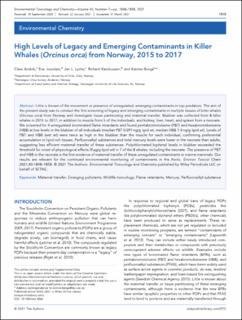High Levels of Legacy and Emerging Contaminants in Killer Whales (Orcinus orca) from Norway, 2015 to 2017
Peer reviewed, Journal article
Published version
Permanent lenke
https://hdl.handle.net/11250/2993565Utgivelsesdato
2021Metadata
Vis full innførselSamlinger
Sammendrag
Little is known of the movement or presence of unregulated, emerging contaminants in top predators. The aim of the present study was to conduct the first screening of legacy and emerging contaminants in multiple tissues of killer whales (Orcinus orca) from Norway and investigate tissue partitioning and maternal transfer. Blubber was collected from 8 killer whales in 2015 to 2017, in addition to muscle from 5 of the individuals, and kidney, liver, heart, and spleen from a neonate. We screened for 4 unregulated brominated flame retardants and found pentabromotoluene (PBT) and hexabromobenzene (HBB) at low levels in the blubber of all individuals (median PBT 0.091 ng/g lipid wt, median HBB 1.4 ng/g lipid wt). Levels of PBT and HBB (wet wt) were twice as high in the blubber than the muscle for each individual, confirming preferential accumulation in lipid-rich tissues. Perfluoroalkyl substances and total mercury levels were lower in the neonate than adults, suggesting less efficient maternal transfer of these substances. Polychlorinated biphenyl levels in blubber exceeded the threshold for onset of physiological effects (9 µg/g lipid wt) in 7 of the 8 whales, including the neonate. The presence of PBT and HBB in the neonate is the first evidence of maternal transfer of these unregulated contaminants in marine mammals. Our results are relevant for the continued environmental monitoring of contaminants in the Arctic. Environ Toxicol Chem 2021;40:1850–1860. © 2021 The Authors. Environmental Toxicology and Chemistry published by Wiley Periodicals LLC on behalf of SETAC.
